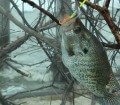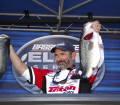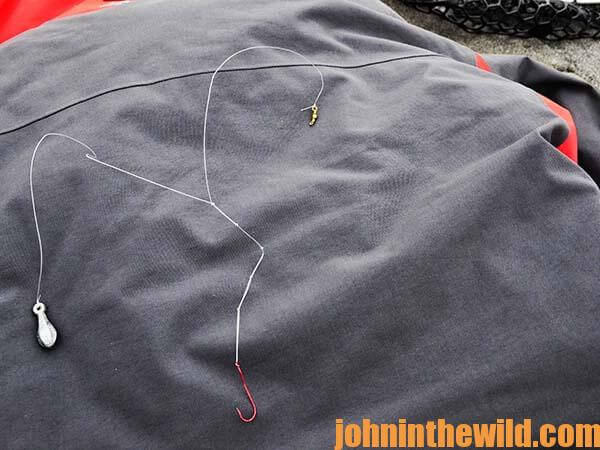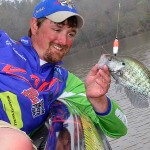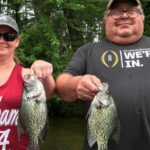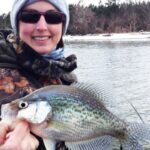John’s Note: Bass fishermen use search baits – lures they can fish quickly and get reaction strikes on – to let the anglers know where the bass are. Then an angler can slow down and fish that school of bass with a slower, more targeted lure. Crappie fisherman and guide Kyle Schoenherr has a similar technique when searching for crappie.
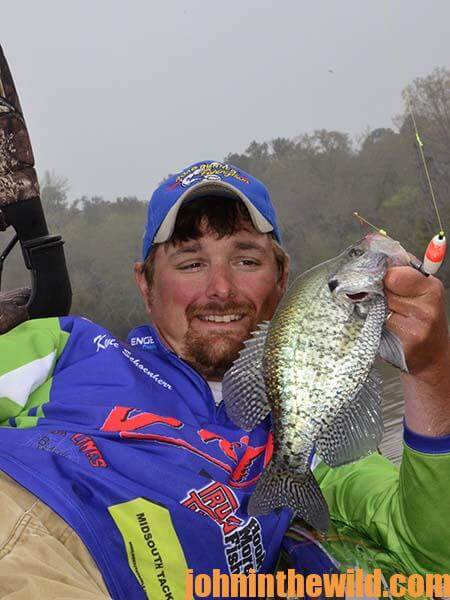 I like to use live minnows on a slip cord. I have designed my slip cord tactic just for fishing bushes.
I like to use live minnows on a slip cord. I have designed my slip cord tactic just for fishing bushes.
I have a # 2 Tru-Turn crappie hook (www.tru-turn.com) tied to the line, two small glow beads up the line and two bullet weights above the beads. One of the bullet weights points down toward the hook, and the other bullet weight rests on the other weight and points up toward the tip of the pole. This way, the bullet weight pointing down allows me to drop the minnow straight through the hole in the brush. Then, when I want to pull my cork and bait out of the bush, the top bullet weight keeps the line and the minnow coming straight out of the bush. I use a cigar-shaped Styrofoam float that’s big enough to hold up the bullet weights above the weights and the minnow. I use a string stop instead of a rubber bobber stopper, because the string is less likely to hang on the limbs of a bush than the rubber is. Another advantage to using the weights on the line is if your hook gets hung, you can shake your line up and down. Those weights will help pull the hook off the limb where you’re hung.
If the crappie attacks the minnow, then we easily can fish right back in that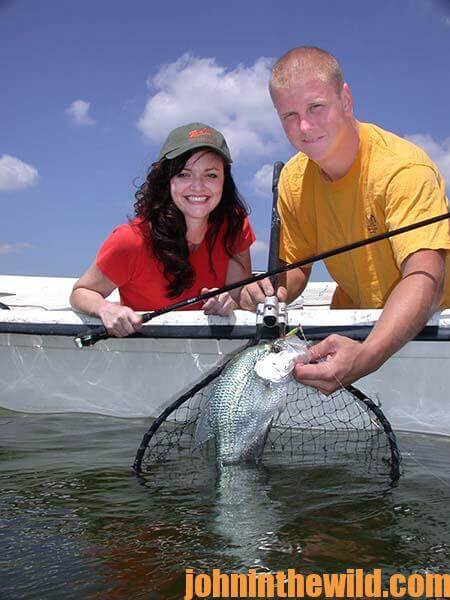 same cover with a jig. Later into the summer, when the crappie are deep, we’ll move out to river and creek channels and fish natural structure like roots, stumps and cover that we see on our depth finders along the edges of old creek or river channels. During the summer or winter months, crappie really go deep in my section of the country. The deepest I ever caught crappie has been in 58 feet of water during the winter on Lake Kinkaid when the crappie were right on the bottom. I had to use a drop-shot rig to get my minnow down quickly and be able to feel the bite in that deep water. With better electronics like the side scanning depth finder, crappie can be caught in much-deeper water during the summer and winter months than most crappie fishermen ever have fished.
same cover with a jig. Later into the summer, when the crappie are deep, we’ll move out to river and creek channels and fish natural structure like roots, stumps and cover that we see on our depth finders along the edges of old creek or river channels. During the summer or winter months, crappie really go deep in my section of the country. The deepest I ever caught crappie has been in 58 feet of water during the winter on Lake Kinkaid when the crappie were right on the bottom. I had to use a drop-shot rig to get my minnow down quickly and be able to feel the bite in that deep water. With better electronics like the side scanning depth finder, crappie can be caught in much-deeper water during the summer and winter months than most crappie fishermen ever have fished.
To fish deep in the summer and winter, I use a bank sinker on the bottom of my line. If I’m fishing 20-feet deep water, I’ll use a 1/2-ounce bank sinker. Fishing in 10 -15 feet of water, I’ll have a 1/8- or 1/4-ounce sinker. About 10-inches above my sinker, I’ll tie a loop in my line. Then, I’ll tie four or five overhand knots in that loop, before I stick the loop through the eye of a #2 Eagle Claw crappie hook (www.eagleclaw.com). I’ll bait with a minnow.
I like overhand knots in my loop, because those knots add strength to the loop in the line and cause the loop in the line to stand out away from the main line
The minnow has more mobility with this style of loop than if I use a pre-manufactured minnow rig with a wire coming out from the main line. I’ll have a barrel swivel about 10 -12 inches above my loop, and tie my main line onto the barrel swivel. By using this type of minnow rig, I can follow the crappie out to deeper water, as they move from the shallow spawning flats out to the staging areas where they usually hold right after the spawn, often in 6 -15 feet of water. I still can fish for them when they move to their summer deep-water holding areas – often at 10-20 feet deep. Many crappie fishermen don’t realize that after the spawn they still can catch crappie all year long.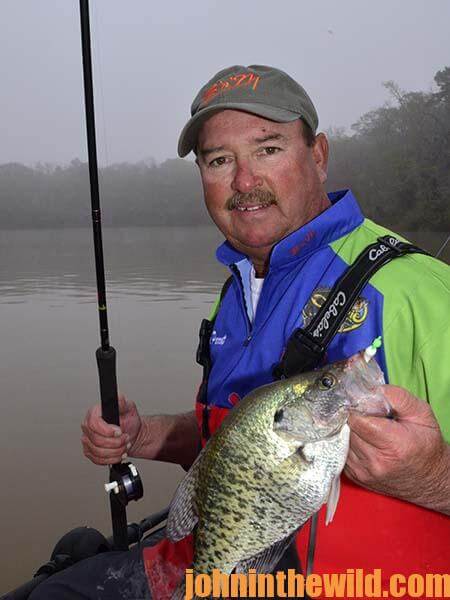
Crappie have to eat every day. To catch them, locate the crappie with your depth finder, and put baits in front of them that they’ll eat. Of course crappie don’t feed all day, every day. For this reason, once you start finding schools of crappie, try, and locate as many schools as you can. Then set up a milk run. You fish each school of crappie that you find several times during the day. Another fact to remember is that the crappie move in and out of cover. If you have a brush pile or stump where you’ve caught crappie before, the next time you go fishing, check that spot with your depth finder. But if you don’t see any crappie holding there, come back at a different time of day. The crappie may have moved in and be holding on that spot for a certain period of time.
Go to Kyle Schoenherr’s website: www.allseasonscrappiefishing.com to learn more.
For more crappie fishing tips, get John E. Phillips’ Kindle eBooks “Crappie: How to Catch Them Fall & Winter,” “Crappie: How to Catch Them Spring and Summer,” “Catch Cold Water Crappie Now,” and “Reelfoot Lake: How to Fish for Crappie, Bass, Bluegills and Catfish & Hunt for Ducks.” Click here to get these books.
Share this page with a friend!
About the Author
John Phillips, winner of the 2012 Homer Circle Fishing Award for outstanding fishing writer by the American Sportfishing Association (ASA) and the Professional Outdoor Media Association (POMA), the 2008 Crossbow Communicator of the year and the 2007 Legendary Communicator chosen for induction into the National Fresh Water Hall of Fame, is a freelance writer (over 6,000 magazine articles for about 100 magazines and several thousand newspaper columns published), magazine editor, photographer for print media as well as industry catalogues (over 25,000 photos published), lecturer, outdoor consultant, marketing consultant, book author and daily internet content provider with an overview of the outdoors. Click here for more information and a list of all the books available from John E. Phillips.

